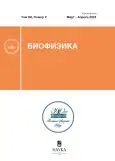Investigating the Physiological Role of Spectral Composition of Daily Light Exposure in the Development of Childhood Myopia
- Authors: Trofimova N.N1, Petronyuk Y.S1, Khramtsova E.A1, Sokolova V.V1,2, Antipova K.G3, Gurieva T.S4, Mednikova E.I4
-
Affiliations:
- N.M. Emanuel Institute of Biochemical Physics, Russian Academy of Sciences
- Р.N. Lebedev Physical Institute, Russian Academy of Sciences
- National Research Centre “Kurchatov Institute”
- Institute of Biomedical Problems, Russian Academy of Sciences
- Issue: Vol 69, No 2 (2024)
- Pages: 371-376
- Section: Articles
- URL: https://journals.rcsi.science/0006-3029/article/view/257588
- DOI: https://doi.org/10.31857/S0006302924020202
- EDN: https://elibrary.ru/OTJRBA
- ID: 257588
Cite item
Full Text
Abstract
About the authors
N. N Trofimova
N.M. Emanuel Institute of Biochemical Physics, Russian Academy of Sciences
Email: ntrofimova@mail.ru
Moscow, Russia
Y. S Petronyuk
N.M. Emanuel Institute of Biochemical Physics, Russian Academy of SciencesMoscow, Russia
E. A Khramtsova
N.M. Emanuel Institute of Biochemical Physics, Russian Academy of SciencesMoscow, Russia
V. V Sokolova
N.M. Emanuel Institute of Biochemical Physics, Russian Academy of Sciences; Р.N. Lebedev Physical Institute, Russian Academy of SciencesMoscow, Russia; Moscow, Russia
K. G Antipova
National Research Centre “Kurchatov Institute”Moscow, Russia
T. S Gurieva
Institute of Biomedical Problems, Russian Academy of SciencesMoscow, Russia
E. I Mednikova
Institute of Biomedical Problems, Russian Academy of SciencesMoscow, Russia
References
- Holden B. A., Fricke T. R., Wilson D. A., Jong M., Naidoo K. S., Sankaridurg P., Wong T. Y., Naduvilath T. J., and Resnikoff S. Global prevalence of myopia and high myopia and temporal trends from 2000 through 2050. Ophthalmology, 123 (5), 1036–1042 (2016). doi: 10.1016/j.ophtha.2016.01.006
- Smith E. L. 3rd and Hung L. F. Form-deprivation myopia in monkeys is a graded phenomenon. Vision Res., 40 (4), 371–381 (2000). doi: 10.1016/s0042-6989(99)00184-4
- Апрасюхина Н. И. Основы анатомии и физиологии детей раннего и дошкольного возраста (ПГУ, Новополоцк, 2015).
- Foulds W., Barathi V., and Luu D. Progressive myopia or hyperopia can be induced in chicks and reversed by manipulation of the chromaticity of ambient light. Invest. Ophthalmol.Vis. Sci., 54, 8004–8012 (2013). doi: 10.1167/iovs.13-12476
- Пигирева М. Д. и Афанасьев Г. Д. Перепеловодство (Росагропромиздат, М., 1989).
- Rucker F. Monochromatic and white light and the regulation of eye growth. Exp. Eye Res., 184, 172–182 (2019). doi: 10.1016/j.exer.2019.04.020
- Mc Brien N. A., Moghaddam H. O., New R., and Williams L. R. Experimental myopia in a diurnal mammal (Sciurus carolinensis) with no accommodative ability. J. Physiol., 469, 427–441 (1993). doi: 10.1113/jphysiol.1993.sp019821
- Schaeffel F. and Howland H. C. Properties of the feedback loops controlling eye growth and refractive state in the chicken. Vision Res., 31, 717–734 (1991). doi: 10.1016/0042-6989(91)90011-S
- Wallman J. and Winawer J. Homeostasis of eye growth and the question of myopia. Neuron, 43, 447–468 (2004). doi: 10.1016/j.neuron.2004.08.008
- Ультразвуковые исследования в офтальмологии: Руководство для врачей. Под ред. В. В. Нероева и Т. Н. Киселевой («ИКАР», М., 2019).
- Troilo D., Smith E. L. 3rd, Nickla D. L., Ashby R., Tkatchenko A. V., Ostrin L. A., Gawne T. J., Pardue M. T., Summers J. A., Kee C., Schroedl F., Wahl S., and Jones L. IMI – Report on experimental models of emmetropization and myopia. Invest. Ophthalmol.Vis. Sci., 60, M31–M88 (2019). doi: 10.1167/iovs.18-25967
- Wisely C. E., Sayed J. A., Tamez H., Zelinka C., Abdel-Rahman M. H., Fischer A. J., and Cebulla C. M. The chick eye in vision research: An excellent model for the study of ocular disease. Prog. Retin. Eye Res., 61, 72–97 (2017). doi: 10.1016/j.preteyeres.2017.06.004
- Nickla D. Ocular diurnal rhythms and eye growth regulation: Where we are 50 years after Lauber. Exp. Eye Res., 114, 25–34 (2013). doi: 10.1016/j.exer.2012.12.013
- Ostrin L. A. Ocular and systemic melatonin and the influence of light exposure. Clin. Exp. Optom., 102, 99–108 (2019). doi: 10.1111/cxo.12824
- Mizutani M. Establishment of inbred strains of chicken and japanese quail and their potential as animal models. Exp. Anim., 51, 417–29 (2002). doi: 10.1538/expanim.51.417
- Coleman D., Silverman R. H., Chabi A., Rondeau M. J., Shung K., Cannata J., and Lincoff H. High-resolution ultrasonic imaging of the posterior segment. Ophthalmology, 111, 1344–1351 (2004). doi: 10.1016/j.ophtha.2003.10.029
- Foster F. S., Zhang M. Y., Duckett A. S., Cucevic V., and Pavlin C. J. In vivo imaging of embryonic development in the mouse eye by ultrasound biomicroscopy. Invest. Ophthalmol. Vis. Sci., 44, 2361–2366 (2003). doi: 10.1167/iovs.02-0911
- Pavlin C., Easterbrook M., Hurwitz J., Harasiewicz K., and Foster F. S. Ultrasound biomicroscopy in the assessment of anterior scleral disease. Am. J. Ophthalmol., 116, 854–857 (993). doi: 10.1016/S0002-9394(14)73207-6
- Nakamura Y., Kusano K., Nakamura K., Kobayashi K., Hozumi N., Saijo Y., and Ohe T. A new diagnostic feasibility for cardiomyopathy utilizing acoustic microscopy. World J. Cardiovasc. Dis., 3, 22–30 (2013). doi: 10.4236/wjcd.2013.31006
- Xie R., Qiu B., Chhablani J., and Zhang X. Evaluation of choroidal thickness using optical coherent tomography: A Review. Front. Med. (Lausanne), 3, 783519 (2021). doi: 10.3389/fmed.2021.783519
- Zakutailov K. V., Levin V. M., and Petronyuk Y. S. High-resolution ultrasonic ultrasound methods: Microstructure visualization and diagnostics of elastic properties of modern materials (Review). Inorg. Mater. 46, 1655–1661 (2010). doi: 10.1134/S0020168510150100
- Петронюк Ю. С., Храмцова Е. А., Левин В. М., Бонарцев А. П., Воинова В. В., Бонарцева Г. А., Мураев А. А., Асфаров Т. Ф. и Гусейнов Н. А. Развитие методов акустической микроскопии для наблюдения процессов остеогенеза в регенеративной медицине. Изв. РАН. Сер. физ., 84 (6), 799–802 (2020). doi: 10.31857/S0367676520060204
- Петронюк Ю. С., Трофимова Н. Н., Зак П. П., Храмцова Е. А., Андрюхина О. М., Андрюхина А. С., Рябцева А. А., Гурьева Т. С., Медникова Е. И., Титов С. А. и Левин В. М. Исследование глазных патологий на биомодели японского перепела Coturnix japonica. Хим. физика, 41 (2), 27–33 (2022). doi: 10.31857/S0207401X22020078
- Хилл К., Тер Хаар Г. и Бэмбер Дж. Ультразвук в медицине. Под ред. О. А. Сапожникова и др. (Физматлит., М., 2008).
- Трофимова Н. Н., Петронюк Ю. С., Гурьева Т. С., Медникова Е. И. и Зак П. П. Влияние спектральной составляющей повседневного освещения на формирование структур глаза японского перепела Coturnix japonica. Сенсорные системы, 36 (3), 226–233 (2022). doi: 10.31857/S0235009222030088
Supplementary files










